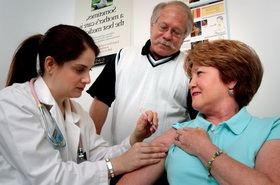- Author: AJMC.com by Alison Rodriguez

There is a significant prevalence of diagnosed HIV infection among Hispanics/Latinos in the United States compared with non-Hispanic whites. Researchers recently aimed to describe characteristics of Hispanics/Latinos in medical care by sex in order to identify disparities, emphasizing the need to decrease ethnic disparities in order to reach national prevention goals across populations.
The report, published by the CDC, used the 2013 and 2014 cycles of the Medical Monitoring Project (MMP) to collect demographic, behavioral, and clinical characteristic data among Hispanics/Latinos by sex.
The data revealed that Hispanic/Latina women were significantly more likely than men to live in poverty, report not speaking English well, and receive interpreter, transportation, and meal services. However, there were no significant differences between Hispanic/Latino women and men in prescription of antiretroviral therapy or sustained viral suppression, according to the report.
The lack of significant differences in clinical outcomes among Hispanic/Latino women and men may demonstrate a higher use of ancillary services by women, according to the authors.
“Levels of viral suppression for Hispanics/Latinos are lower than those found among non-Hispanic whites and lower than the national prevention goal of at least 80% of persons with diagnosed HIV infection,” the authors noted. “Providers should be cognizant of the challenges faced by Hispanics/Latinos with HIV infection in care and provide referrals to needed ancillary services.”
The data collected from the MMP included 1774 men and 577 woman who self-identified as Hispanic or Latino. The report noted that 78% of Hispanic/Latina women receiving HIV care lived at or below the federal household poverty level, compared with 54% of men. This is significant because the management of HIV care is known to be affected by poverty at all stages of the HIV care continuum. However, the higher reportage of meal and transportation services among women may helped certain negative consequences to their clinical outcomes.
“Overall, 38% of women and 21% of men reported not speaking English well, which can affect ability to understand a provider's instructions and ability to navigate the healthcare system,” the report stated. “In addition, the language barrier might prevent care providers from understanding the patient and could lead to missed opportunities to provide needed support or direction. Bilingual providers or interpreter services might have mitigated linguistic barriers.”
The report concluded it is necessary for providers to be aware of the challenges faced by this population and to improve access to ancillary services. Ethnic disparities need to be reduced in order to attain national prevention goals among this population, despite the lack of disparity found in viral suppression in HIV care in this report.
Source: Published originally on www.ajmc.com, Disparities in HIV Care Among Hispanic/Latino Men and Women, by Alison Rodriguez, December 1st, 2018.


